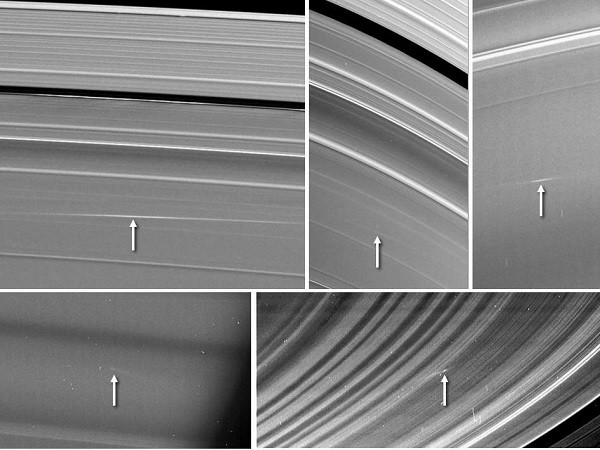
NASA's Cassini spacecraft has found first direct evidence of small meteoroids breaking into streams of rubble and crashing into Saturn's rings.
The solar system is full of small, speeding objects. It is difficult for scientists and astronomers to observe the impact of meteors on the planetary bodies as they occur. The latest observations of meteors hitting Saturn's majestic rings makes the planet's rings the only location besides Earth, moon and Jupiter where scientists have been able to observe the impact of meteor strike.
By studying the impact rate of meteoroids from outside the Saturnian system, it would help scientists understand how different planets were formed in our solar system. According to researchers, the size of the small objects that struck Saturn's rings range from one centimetre to several metres. Their size is comparable to the meteor that streaked across the Russian sky in February. It took years for scientists to differentiate the tracks left by nine meteoroids on Saturn in 2005, 2009 and 2012.
The Saturnian equinox in summer 2009 was the best time to view the debris left by meteoroid impacts. The shallow sun angle on the rings caused the debris to look bright against the darkened Saturn's rings.
"We knew these little impacts were constantly occurring, but we didn't know how big or how frequent they might be, and we didn't necessarily expect them to take the form of spectacular shearing clouds," Matt Tiscareno, lead author of the paper and a Cassini participating scientist at Cornell University in Ithaca, NY, said in a statement.
"The sunlight shining edge-on to the rings at the Saturnian equinox acted like an anti-cloaking device, so these usually invisible features became plain to see."
According to NASA scientists, Saturn's rings are very effective and acts like a giant meteoroid detector that can detect even the interior structure of the planet and the orbits of its moons. "For example, a subtle but extensive corrugation that ripples 12,000 miles (19,000 kilometers) across the innermost rings tells of a very large meteoroid impact in 1983," said researchers. These results suggest that the impact rates for small particles at Saturn are about the same as those at Earth, despite the planets being two different neighbourhoods in our solar system.
Researchers assume that the meteoroids first break into small objects as soon as they come in contact with Saturn's rings. These smaller objects enter into the orbit around Saturn. These tiny particles have a range of orbital speeds around Saturn. Their impact into Saturn's rings leads to the formation of clouds that are pulled into diagonal, extended bright streaks.
Some scientists suggest that Saturn's rings are much younger than the planet itself, as the rings are bright and clean. "To assess this dramatic claim, we must know more about the rate at which outside material is bombarding the rings. This latest analysis helps fill in that story with detection of impactors of a size that we weren't previously able to detect directly," said co-author Jeff Cuzzi, a Cassini interdisciplinary scientist specializing in planetary rings and dust at NASA's Ames Research Center in Moffett Field, Calif.
The details of the findings appear in the journal Science.

















